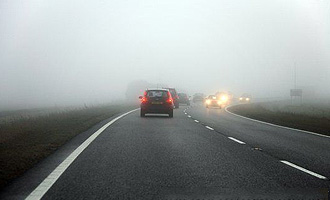| Driving in Bad Weather | << Back to Education |
Driving in Fog
When there's fog around visibility can seriously deteriorate in a matter of seconds. Be extra vigilant and drive only as fast as conditions allow and maintain a greater distance between you and the car in front.
If you need to use fog lights they must be switched off when visibility improves. This applies equally to front and rear fog lights.

Before You Leave
| Only make journey's in fog if they are absolutely neccessary. | |
| Clean your windows and windscreen and ensure all your lights are working. | |
| Plan your route before you go to avoid distractions while driving. | |
| Make sure you have enough fuel for your journey and allow extra time as traffic will be slow moving. | |
| Take extra, warm clothing in case of breakdown or delays. |
Top 10 Tips
| Use dipped headlights at all times along with wipers and demisters. | |
| Familiarise yourself with your front and rear fog lights – know how to switch them on and off – and use them when appropriate. | |
| Beware of other drivers not using headlights. | |
| Only drive as fast as conditions allow and maintain a greater distance between you and the car in front. Follow a three-second rule. | |
| Tailing someone's rear lights can give a false sense of security and is dangerous. | |
| If the road has street lights on, then you probably don't need your fog lights on. | |
| Be able to stop within the distance you can see clearly – this is particularly important on motorways and dual carriageways, as vehicles are travelling faster. | |
| Don't accelerate to get away from a vehicle that is too close behind you. | |
| Check your mirrors before you slow down. | |
| At a junction with limited visibility, stop, wind down the window, and listen for traffic. When you are sure it is safe to emerge, do so positively and do not hesitate in a position that puts you directly in the path of approaching vehicles. |
© ![]() has compiled this information to be used for educational purposes only
has compiled this information to be used for educational purposes only
